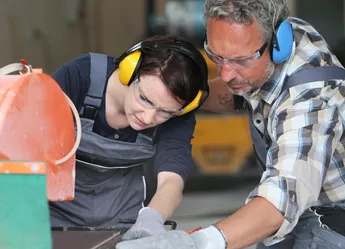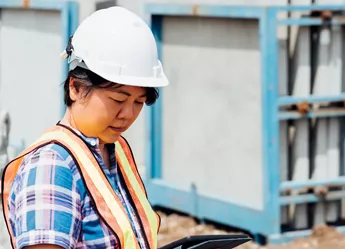Innovation is one of the key principles that underlie the UK construction industry. Being willing and able to innovate means getting more from your projects than you otherwise would. With the cost of construction rising around the UK and knowledge leaving the industry through an ageing workforce, the construction sector must find a way to put innovation at its heart again if it’s going to thrive.

By its very nature, R&D in the construction industry is rooted to innovation. From developing advanced materials and sophisticated tools to devising whole new processes and approaches, every project demands its own set of solutions and poses its own unique challenges. The building trade does its best, most forward-thinking work under intense pressure. It’s inspirational to those of us with an eye on innovation, but there’s a danger that comes with it.
Every year, the construction industry finds ways to push back the boundaries of what we know and what we can accomplish. However, that same innovative spirit is so much an accepted part of “business as usual” that it’s being swept under the carpet. The everyday challenges facing the industry are being met, but the full rewards just aren’t being realised. That’s a significant enough problem in itself – one that’s seeing great numbers of businesses never receiving, or even claiming, the incentives and rewards they deserve. Combined with the mounting skills crisis, though, there’s a real danger of strangling the spirit of innovation right out of the industry.
At the heart of the construction skills shortage is some fairly brutal mathematics. Right now, we’ve got more skilled workers either retiring from or quitting the industry than we have new blood coming in to replace them. That increasing strain on an overstretched workforce is driving up project costs and squeezing down margins throughout the sector. Investors are becoming jumpy and less keen to pump speculative money into the building trade. Meanwhile, construction firms already struggling to find a competitive advantage are shying away from more innovative, potentially riskier projects.
With the changing employment environment around Brexit, there’s a serious question hanging over the future of the 165,000 construction jobs currently filled by EU nationals. The industry needs an estimated 150,000 new pairs of boots on the ground by 2021 just to keep pace with existing demand levels, and it’s not at all clear where these new workers will be coming from.

Tackling the skills crisis is going to take serious commitment, and there’s no single “silver bullet” solution. Technology and automation have enormous potential – not just to take up the slack, but to broaden our understanding of what it actually means to work in construction.
Of course, we’re again talking about weaponising innovation here, which is a challenging task when anxiety in the industry is threatening to stifle construction’s biggest ideas. In addition, a more automated, digital construction workplace isn’t just a matter of reducing the reliance on skilled manpower. A whole new range of skills will be needed to operate in that environment, and the people with those skills aren’t traditionally drawn or guided toward construction as a potential career. Trading one set of conventional skill shortages for another, more technical one gets us nowhere.
So, the challenge becomes drawing people with the right skills (both for right now and the more automated future) into the building trade, while making the most of those we still have. Reaching out to educators is a strong move, and one that’s already underway to some extent. It’s a question of shifting the whole conversation about construction, and doing much more to demonstrate that it’s a career with genuine prospects. Stereotypes are difficult to break, but it needs to be done through outreach and education.

Moving onto specialised training programmes, again, steps are already being taken. £1 billion have already been put into training and apprenticeships, but without any guarantee of a stable job at the end of them, they can still be a hard pill to swallow for many. Outreach is still a key issue, with businesses needing to build better relationships with training providers and colleges.
At the same time, the industry needs to be doing more with the workforce it still has. 60% of construction employers have already got this message, offering a clear path for skills development internally. There are also initiatives like the National Retraining Scheme, which works to prepare people for the kinds of changes we’ll be seeing as technology continues to reshape the jobs we do and the ways we do them.
As for the innovation we’re hoping to encourage, it’s essential that construction businesses both understand and receive the true value of their biggest ideas. At the moment, an average of less than 1% of a typical UK construction firm’s revenue goes back into R&D projects.
Construction is among the most stubbornly non-digitised sectors in the entire economy, despite its position as one of its most aggressively innovative. That needs to change, but construction businesses are becoming, by necessity, too rigidly focused on day-to-day survival to swallow the risks traditionally associated with bold innovation.

Construction is still incredibly under-represented in R&D Tax Credits claims. In fact, just 3% of qualifying R&D claims currently come from the building trade. The R&D Tax Credits scheme is the largest and most valuable of its kind. It’s purpose-built to make innovation more rewarding and less risky. We’ve already touched on the importance of shifting the way people think about construction.
Beyond that, the sector needs to change the way it thinks about itself. The fact that solving problems and negotiating obstacles are routine can’t be allowed to stand in the way of reaping their benefits. Innovation doesn’t “belong” to any one industry or discipline, but the organisations that make early use of new developments tend to gain the most from them. Head-up displays, remote drones and even bricklaying robots are all finding places on the modern construction site. We can only see the very tip of the technical iceberg from here, but leaning into new technologies like these has the potential to tend the wounds of an industry that’s bleeding manpower at a dangerous pace.
The choice facing UK construction is pretty black-and-white: evolve or stagnate. Innovation always involves an element of risk. Ensuring that innovation pays is the key to overcoming the stifling effect of the skills shortage, and attacking the crisis itself.
The challenges face working in the construction industry can be tremendous, with innovation and ingenuity needed at every turn to overcome everyday challenges. We have construction experts within our RIFT R&D team who are on hand to explain R&D tax credits and put momentum behind your claim, to maximise your entitlement and ensure no stone is left unturned.

